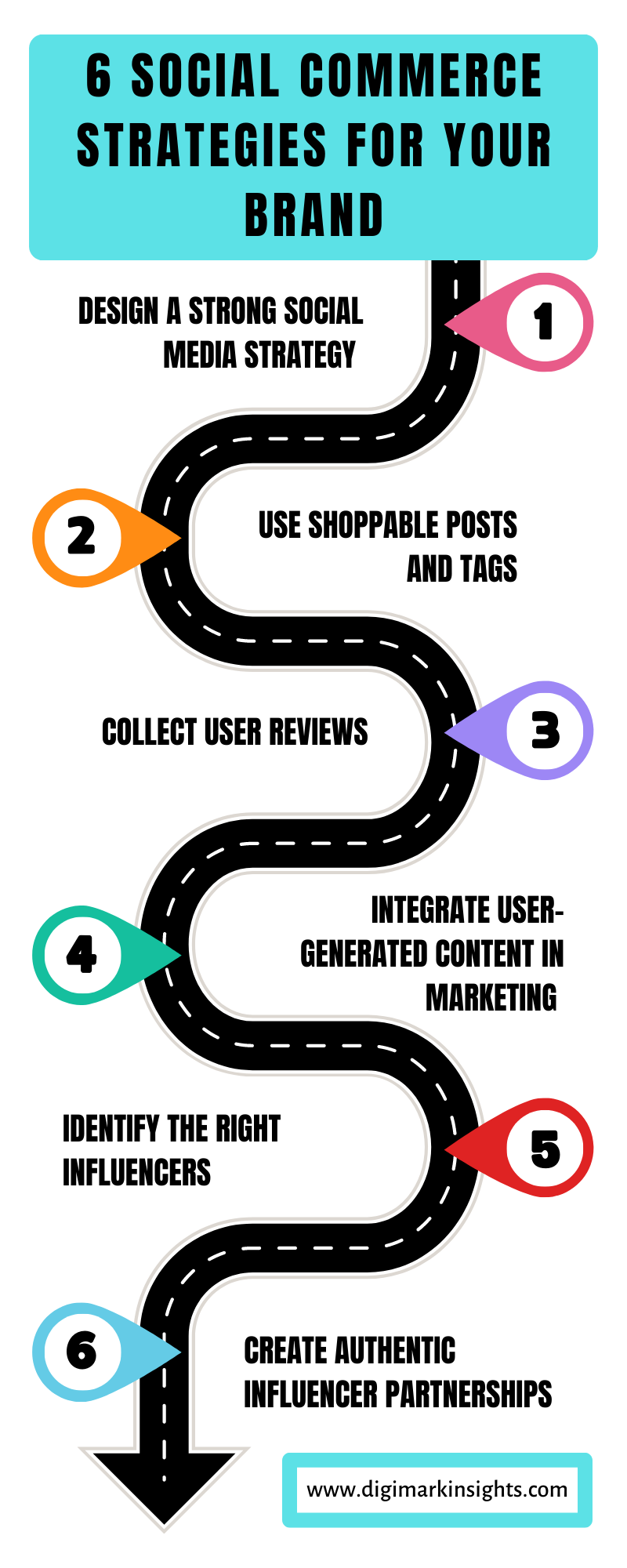Social commerce in digital marketing is a revolutionary idea that connects social networking with online shopping. It makes product discovery into a smooth shopping experience by enabling users to purchase products right within their preferred social networking sites.
Social commerce is getting increasingly popular in the world of digital marketing as the influence of social media has expanded onto consumer behavior. Nowadays, brands leverage the power of social commerce to reach out to the customers with irresistible product offers at just the right time and engage them in a more personalized way.
Social commerce is an emerging trend that is shifting how businesses interact with their customers and raise conversions.

Understanding Social Commerce in Digital Marketing
Defining Social Commerce
Social commerce is a dynamic blend of social media and e-commerce. Social commerce allows customers to make purchases instantly within their preferred social networking platforms.
This is in contrast to traditional e-commerce, which requires customers to search through specific online businesses or websites. Social commerce turns the engagement on social media into an entirely immersive purchasing experience.
Brands can bring their products to attention by partnering with influencers to create appealing posts and videos. These posts frequently attach links or shoppable tags that allow users to easily click and buy without leaving the social media site. The path to purchase is streamlined by this seamless process, maximizing convenience and impulsive buying.
Additionally, social commerce makes benefit of user-generated content by inducing users to post testimonials, unboxing videos, and reviews, which promotes authenticity and trust. The borders between socializing and buying are obscured by this modern e-commerce approach, providing marketers with a personalized and interactive way to engage their audience and increase conversions.
The Role of Social Media Platforms

Social media platforms have been key in promoting the social commerce sector’s explosive expansion. These platforms have evolved into virtual markets with billions of engaged users for brands. Social media platforms’ influence on the growth of social commerce is largely due to a number of important factors, such as:
- Massive Reach and Engagement:
Huge user bases can be found on social media websites like Instagram, Facebook, Pinterest, and Twitter. Brands can employ these platforms to further their goods, connect to a larger audience, and interact with consumers. This will eventually improve website traffic and sales.
Related: Social Media Marketing Success with Instagram Threads: The Next Big Thing
- Seamless Shopping Experience:
Social media networks have grown to easily integrate the retail function. Shrink the number of steps of the marketing funnel by streamlining the shopping experience with clickable posts, product tags, and in-app checkout options.
- User-Generated Content and Social Proof:
User-generated content (UGC) is very critical in social commerce. Customers forward their opinions, experiences, and recommendations, creating social proof which helps brands build credibility and convince new customers.
- Influencer Marketing:
Influencer marketing flourishes on social media outlets. Brands collaborate with influencers who have a sizable fan base to obtain access to a highly motivated and intent audience. Influencers can promote goods in a genuine way, increasing interest and sales.
- Real-Time Interactions:
Social media platforms provide on the spot communication, connecting businesses and consumers. By responding to queries, resolving issues, and extending tailored advice, brands encourage a sense of client loyalty and may build a community.
Related: How to Livestream Your Business: Tips to Make Immediate Sales
- Data and Insights:
Platforms for social media generate massive amounts of user data. In order to adjust their marketing strategies and provide more relevant content and offers, brands can utilize this data to analyze client preferences, behavior, and trends.
- Social Sharing and Virality:
Sharing drives and thrives social media. When consumers find something adorable and shareworthy, they frequently update their social networks about it, potentially increasing brand publicity exponentially.
- Social Advertising and Targeting:
Social media networks offer effective targeting and advertising options. Based on user demographics, interests, and behaviors, brands can design highly targeted advertising campaigns that heighten the likelihood that the right audience will get the right message.
The Impact of Social Commerce on Digital Marketing
Social marketing has reformed digital marketing, and has also altered how firms interact with their audience. Consumer behavior is affected, brand engagement amplifies, and conversions skyrocket. Social commerce strengthens authentic connection and improves the overall buying experience, establishing its position as a game-changer in the industry.
A. Customer Behavior and Buying Habits
The consumer’s decision making process is greatly shaped by social commerce. It provides a smooth path to purchase by incorporating shopping features within social networking platforms.
As a result, friction is significantly reduced and impulsive buying is encouraged. Social media user-generated content and genuine user reviews shape consumer perceptions and increase their trust and confidence in the product. Further, influencer marketing impacts consumer decisions as people tend to believe advice from the influencers they follow.
Convenience, social proof, and personalized involvement are all combined in social commerce, encouraging customers to make informed purchasing decisions.
Also read: Personalization in Digital Marketing for 2023: Skyrocket Conversions
B. Brand Engagement and Awareness
Brands may use social commerce to foster interaction and enhance brand visibility through a variety of tactics. They effortlessly incorporate products into social media content, driving direct transactions, by developing engaging shoppable posts and tags.
Related: Use Hyperlocal Social Media Marketing to Boost Your Local Business
Brands can include interactive features, such as surveys, opinion polls, and live sessions to develop a sense of community and promotes engagement. Additionally, by using social media advertising and retargeting, products are kept in front of prospective customers, enhancing brand presence. Employing social media to sell products and services grows company’s awareness, bringing in new client.
C. Influencer Marketing and User-Generated Content

In social commerce, user-generated content (UGC) and influencers are key factors.
Brands are able to reach a target demographic through the help of influencers, as people are more likely to rely on and follow their advice compared to traditional celebrities. UGC generates social proof and authenticity through product reviews, consumer testimonials, and unboxing videos. Influencers and user-generated content (UGC) work collectively to boost brand credibility, and compliment the success of social commerce campaigns.
Social Commerce Strategies in Digital Marketing for Brands
Now that we understand the importance of social commerce, how do we use it to promote our brand?
Businesses use powerful techniques to take advantage of social commerce as social media platforms transform into online marketplaces. This blog will discuss important social commerce tactics that businesses can use to improve their online visibility and increase revenue.
1. Building a Strong Social Media Strategy
A clear social media strategy is the first step in developing a successful social commerce strategy.
Brands need to pinpoint their target market, investigate their rivals, and choose the best social media channels for their operation. Brands may create content and products that appeal to prospective customers by studying the interests and behavior of their audience. Goals, key performance indicators (KPIs), and content themes are all outlined in a thorough social media plan to provide a unified and interesting presence across all platforms.
2. Utilizing Shoppable Posts and Tags
Shoppable post integration with product tags is one of the most effective social commerce strategies.
You can now tag products on social media sites like Instagram and Facebook, so people can simply click on them to learn more and make purchases. Shoppable posts make the buying process friction-free, offer a seamless user experience, and promote impulsive purchases.
3. Encouraging User Reviews and Testimonials
In social commerce, user-generated content (UGC) is a potent instrument. You can encourage your customers to share their opinions, recommendations, and experiences. This generates vital social proof that builds trust with prospective customers.
You can offer incentives like discounts or special deals to encourage customers to submit reviews on your brand’s website or social media sites. Positive UGC not only increases brand reputation but also has an impact on consumer purchasing behavior since people are more willing to believe the opinions of their peers.
4. Integrating User-Generated Content in Marketing Campaigns

UGC integration into marketing campaigns is a successful strategy for attracting customers and promoting your product.
In order to showcase people using your products, you can collect user-generated photos and videos and use them in your advertising campaigns. This strategy resonates with the target audience and increases the likelihood that it will lead to conversions. Brands build an emotional connection with the audience by sharing firsthand accounts of real consumers using their products.
5. Identifying the Right Influencers for Your Brand
You need to carefully choose the influencers for your brand to make sure their viewpoints and target market are compatible. Real promotions and increased engagement is guaranteed when you collab with influencers who have a true connection with their audience and share identical interests.
To make informed selection for your campaigns, you should examine influencers’ audience demographics, engagement rates, and previous partnerships with other brands.
6. Crafting Authentic and Engaging Influencer Partnerships
For social commerce campaigns to be successful, relationships with influencers must be long lasting. Building genuine ties is what you need to prioritize over one-time endorsements. This involves granting influencers enough room to be creative so they can present your brand in a manner consistent with their particular sense of style and voice.
Challenges and Future Outlook in Social Commerce

Social commerce offers very promising prospects, but it also has its share of challenges. In order for brands to utilize social commerce to the fullest, several issues must be addressed.
- Privacy Issues
Since social media sites gather a lot of user data, privacy problems have gained a lot of attention. Brands must put high priority on data protection and be transparent about how they use consumer data. To establish trust and preserve customer confidence, it is crucial to implement strict privacy policies and get explicit user agreement before using their data for targeted advertising.
- Customer Trust
Building client trust is crucial to social commerce.
Customers require reassurance that the products are genuine and of high quality as companies are increasingly selling their products directly through social media. In order to show their dedication in ensuring customer satisfaction, brands should respond to queries and grievances posted by customers on social media.
The Future of Social Commerce in Digital Marketing

The pace with which social commerce is growing hints to a future in which it will be deeply incorporated in digital marketing. The following trends and developments are expected to shape social commerce in the future:
- Virtual try-ons and Augmented Reality (AR)
AR technology is revolutionizing online retail. Future social commerce is anticipated to include augmented reality (AR) capabilities that let consumers visually try on items like apparel, accessories, and even makeup. The uncertainty associated with online purchases is decreased and customer involvement is increased by this interactive shopping experience.
- Social Commerce on new Platforms
Facebook and Instagram today rule social commerce, but in the future, new platforms are likely to have a bigger impact. Brands aiming to reach active and new audiences are drawn to platforms like TikTok, Snapchat, and Pinterest that are already experimenting with shoppable features.
- Voice Commerce
Voice commerce will have an impact on social commerce as voice assistants like Amazon’s Alexa and Google Assistant become more commonplace. For customers who prefer voice commands over conventional interactions, brands may add speech-based shopping functionality to social networking platforms.
- Social Commerce Analytics and AI
Advanced analytics and artificial intelligence will be the driving forces behind social commerce tactics. To analyse social media data, follow consumer behavior, and forecast buying trends, brands can use AI-powered technologies. Brands will be able to develop more individualized and successful social commerce campaigns thanks to these data.
- Social commerce in livestreams and events
Brands are increasingly showcasing their items through livestream shopping events, which are becoming more and more popular. Social media companies may add more buying features to these events in the future, facilitating instantaneous purchases of featured goods by spectators.
Conclusion
Digital marketing is being revolutionized by social commerce, which provides a seamless purchase experience on social media sites. Brands must use social commerce strategies to stay ahead in the cutthroat marketplace because they have the potential to increase brand visibility, promote engagement, and raise sales. Businesses can succeed in the digital age by utilizing this new trend to engage authentically with consumers.




Pingback: Why You Need to Integrate Voice Search in Digital Marketing - Digimark Insights